The Path By The T-Way
You have probably heard the state government heralding it’s achievement of completing a shared cylepath beside the new North-West T-Way. However, some two years after the other T-Way, from Parramatta to Liverpool via Bossley Park, started carrying buses, the companion cyclepath is still not fully complete to Austroads standard. Remember that this is meant to be a regional cyclepath that is attractive to all manner of riders. The Austroads standard is clear that a regional path should be 2.5 metres wide.
The offending section of the path has been in place for many years. It was built as part of the motorway project through Mays Hill in the 1980’s. During the T-Way development the designers realised this old path runs parallel with part of their bus route, and so ran their cycle route along this existing stretch of narrow concrete.
The old path was never constructed to Austroads standards, but the T-Way path is supposed to be to this standard for it’s entire length. Here’s the proof:
Pearson St right angle turn
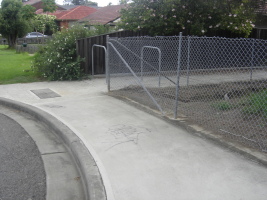
At the end of Pearson St cyclists are expected to make an impossible right angle turn as they negotiate an unpainted grey tube barrier. Most cyclists find this an impossible manoeuvre requiring acrobatic balance and end up paddling through on their feet.
Pearson St squeeze point
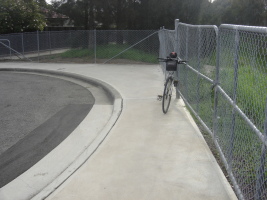
Next is a narrowing of the path to one metre, yes ONE metre, to squeeze past the unused end of a cul-de-sac. You can see in the background the path leading down behind the fence, a short smooth curving path of proper width could be achieved by relocating some fence and about three square metres of extra concrete.
Pearson St barrier
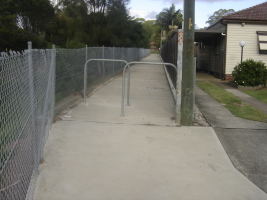
The next obstacle is another grey tubular barrier. This one is mentally destructive as the rider can already see the next barrier up ahead, and so knows in advance that this run on the pedals will be very short lived. These tubular barriers all need to be replaced with single central yellow bollards. This barrier is particularly frustrating as it results in a standing start for an incline that would otherwise be taken at a decent climbing speed.
Frances St barriers
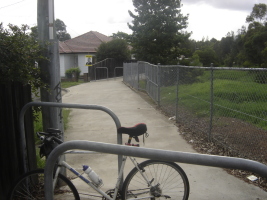
Next we arrive at Frances St, where the cyclist has to negotiate not just one, but two tubular barriers that almost completely block the path. Note also that vehicle access to the path for the twenty metres between the barriers is not denied, so in theory a car could come down the street, fail to stop at the cul-de-dac and strike down a passing cyclist.
Hayes Ave — no barriers
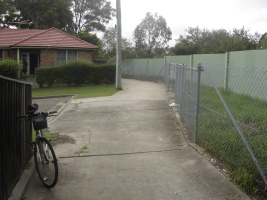
At the next cul-de-sac, yes, there are quite a few of them in this stretch of path, there is not only no protection from out of control vehicles, but there is no barrier to unauthorised entry to the path. At the previous three cul-de-sacs so much effort has gone into constructing barriers that impede path users in order to control cars, and then just up the path less than 100 metres away we find a totally uncontrolled site. I wonder what is the point of barriers in the first place.
Narrow path near Coleman St
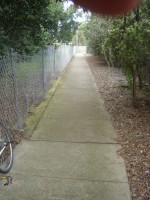
Now we find the path narrows dramatically to around 1.6 metres in width. With the fence on one side restricting handlebar width it is quite narrow to pass oncoming cyclists. Just around the corner there is a pole that even further restricts the usable width.
Squeeze post near Coleman St
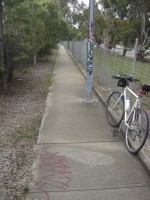
The available width from the post to the concrete edge is a mere 1.0 metres. This is meant to be a two-way, regional path with a design width of 2.5 metres. This squeeze point is less than half the required width. Someone has put some red paint on the pole, either as a warning, or as a prediction of the blood to be spilt here in the future accident. The grey post is particularly dangerous at night. I measured the bicycle passing speed on the downhill direction at 30 kph. This was an aging adult cycling at reasonable pace, not an Olympic sprinter.
Up the path a few metres and it is painfully obvious that the new path was simply added on to the end of the existing narrow path.
Space for more concrete
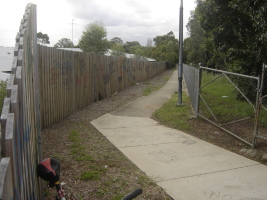
In this area there is clearly ample space within the easement to bring the width of the path up to something approaching the proper Austroads standard width. However in an apparent cost saving measure the new concrete has only been added to the end of the existing pathway.
Coleman St danger barrier
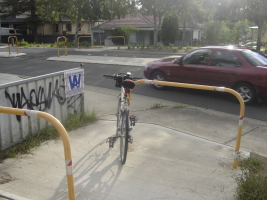
Now comes a new type of obstacle, a barrier that is so close to a road that all but the most balanced cyclist would feel it’s just too risky to attempt the thread between the barrier in case the bike ands up on the road. While the crossing is about ten metres away, the gutter is low enough to confuse cyclists into thinking the crossing is straight ahead. The barriers need replacing; and a fence at the edge of the road is needed. The driveway on the left of picture makes this a challenging location to make safe. The right angle turn is also less than satisfactory.
Rita St barrier
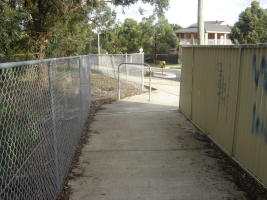
Have you had enough of barriers yet, well there is still one more to negotiate. This is only a single barrier and can be comfortably negotiated, but it’s identical colour and closeness to the fence can make it hard to see, especially at night. There is also a risk of pedestrians coming from behind the fence on right of picture as you join the footpath from the cycleway.
Rita St garden
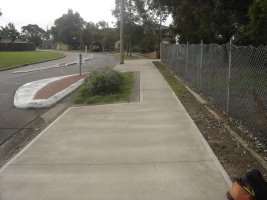
So you thought this was a 2.5 metre wide cyclepath, except for our nice garden. The squeeze point is about 1.2 metres wide at most. Worse still is the fact that the garden is on the side of the path the cyclist naturally flows onto after making the turn from the path behind the trees, creating an interesting zig-zag. The garden has a complete lack of any attempt to make it visible at night.
Laura St fencing
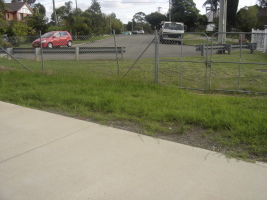
Just in case there’s a cul-de-sac treatment missing from the local selection, the residents of Laura St have to put up with complete isolation from the cyclepath. While the old fence is not very appealing and should be completely replaced, at least one small segment near the gate could be removed to allow residents direct access to and from the path.
Railing around corner
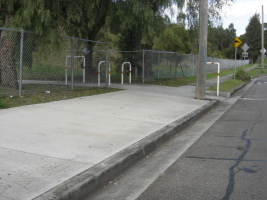
At the next turn, which is another right angle, the cyclist is confronted with a nicely placed triple tube barrier just around the corner. Even the most balanced cyclists find this one almost impossible to negotiate without putting a foot on the ground.
So by now I expect that you assume this entire set of obstacles is spread far and wide over a long stretch of path, right? Wrong. The total distance from the first photo in this series at the Pearson St cul-de-sac to the ‘railing around the corner’ at the Rita St motorway underpass is 800 metres. That’s right, a total of eleven barriers, obstacles or squeeze points, at an average of one every 72 metres. This is not what you would call attractive to cyclists and definitely not satisfactory for a regional cyclepath. Further the state government claims that a cyclepath to Austroads standard would be built alongside the T-Way, yet they left this part out.
Smooth New Bridge Meets Rough Old Path
Just down the path another hundred metres a new bridge over Findlayson Creek has been built. Many hundreds of thousand of dollars has been spent to create a bridge that makes a flowing straight run over the creek.
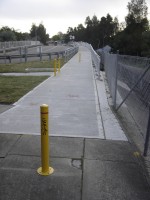
What is the point of making one part of the path straight, smooth and flowing so it is attractive to cyclists when the next kilometre is littered with barriers and obstacles.
What is needed? The RTA, and T-Way builders need to complete the path as well as reasonably possible to the full 2.5 metre width and replace all the barriers with single central bollards. They have carried out remedial treatment to two cul-de-sac areas, what has happened to the rest of them?
Not a great deal needs to be spent; only the one post needs to be moved, or concrete laid around it. Small areas of concrete to smooth out curves, replace the old tubular barriers with single central bollards, fill in the garden, and some bright yellow paint and reflectors on some immovable obstacles. The cost of this remedial action would be quite small compared to the cost of the extravagant bridge that has been constructed over the creek. At the moment, the new bridge is a waste of money as the cyclepath is judged by cyclists based on it’s entire length, not on the hundred metres that crosses the bridge.
